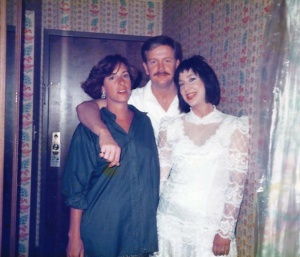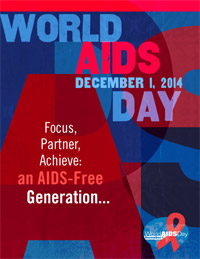
I lost my dear friend Tony M. in 1987 in the first generation of deaths from the scourge of AIDS. Remembering Tony, here he is helping me get dressed on my wedding day, along with my BFF Susan.
When Tony was diagnosed within months of this photo being taken, he was with full-blown AIDS. At that time, Tony had no access to the portfolio of drug therapies available to an HIV+ patient today. Those were the days of denial, experimentation, toxicity, and really, really tough side effects.
We remember Tony and all our loved ones everyday and especially today, on World AIDS Day. This health-holiday was started to raise awareness the preventability of HIV/AIDS, and mobilize partnerships, research, and treatment. Appropriately, this year’s theme is “Focus, Partner, Achieve – an AIDS-free generation.”
In the U.S., tragically, we’ve miles to go to get to that AIDS-free generation. Here are a few realities that can make one lose patience: there are about 1.2 million people living with HIV in the U.S.. and the number of new HIV diagnoses has remained relatively stable from 2008-2012 — not a good sign for preventive efforts, with numbers high among gay and bisexual men, African Americans, and Hispanics and Latinos. 14% of people living with HIV in the U.S. don’t know they have the virus because they haven’t been tested.
 Once diagnosed, HIV care is available and especially important to continue to keep the HIV virus in check — the process called viral suppression.
Once diagnosed, HIV care is available and especially important to continue to keep the HIV virus in check — the process called viral suppression.
In the U.S., only 3 in 10 people with HIV is getting that care — found in the CDC’s latest report on the topic, Vital Signs: HIV Diagnosis, Care, and Treatment Among Persons Living with HIV — United States, 2011.
Health Populi’s Hot Points: It’s more than time to erase the stigma of HIV/AIDS and get on with ensuring that the remaining 7 in 10 people in the U.S. get the care, stick with the care, and live well with the disease.
The key activation point is to get tested, and my friend Ramin Bastani started Healthvana to make accessing test locations, storing, tracking and sharing test results easy and technology smart. The Healthvana app enables a user to find locations of testing centers for STDs, and in a HIPAA-compliant way, have test results communicated back to the person.
Once tested, if found HIV+. the key is to find care and stick with it to keep viral loads down. For a practical guide to self-care with HIV, I recommend looking at the Visiting Nurse Service of New York’s Self-Care Guide. This information is straight-forward, balanced, and pulls no punches about the many aspects of living well with HIV. Like many chronic conditions (think: diabetes, for example) managing HIV is a multi-pronged effort, every single day.
If you are a health provider, you should check out the Institute for Healthcare Improvement’s guide to shared decision-making with patients who are HIV+. Self-efficacy and confidence in managing HIV as a chronic condition is key to living well. IHI has got this just-right in their guide.
Affording medicines is also a challenge, so the Partnership for Prescription Assistance provides this list of drug companies and access programs that can discount prescription drugs for people managing HIV/AIDS.
And Prince Harry, carrying on his Mum’s passion for public health and especially addressing HIV/AIDS, urges all of us to get involved in World AIDS Day, every day, here in this video he recorded for the charity, Sentebale. #FeelNoShame is the Twitter hashtag for their campaign.
Whether you’ve had a wonderful Tony M.-friend in your life or not…today and every day…remember that HIV is a chronic, treatable condition. We are not our diseases. Let us #FeelNoShame.




 I love sharing perspectives on what's shaping the future of health care, and appreciate the opportunity to be collaborating once again with Duke Corporate Education and a global client on 6th May. We'll be addressing some key pillars to consider in scenario planning such as growing consumerism in health care, technology (from AI to telehealth), climate change, and trust -- the key enabler for health engagement or dis-engagement and mis-information. I'm grateful to be affiliated with the corporate education provider
I love sharing perspectives on what's shaping the future of health care, and appreciate the opportunity to be collaborating once again with Duke Corporate Education and a global client on 6th May. We'll be addressing some key pillars to consider in scenario planning such as growing consumerism in health care, technology (from AI to telehealth), climate change, and trust -- the key enabler for health engagement or dis-engagement and mis-information. I'm grateful to be affiliated with the corporate education provider  Thank you FeedSpot for
Thank you FeedSpot for